
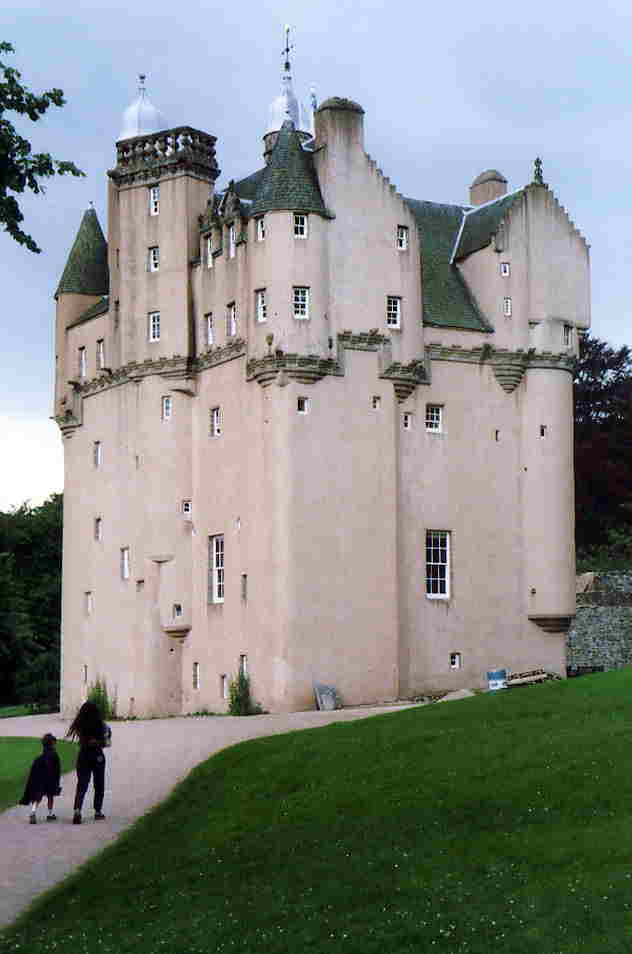
Craigievar Castle is a stunning pink castle located in Alford, Aberdeenshire, Scotland. The castle was built in the late 16th century by William Forbes and is an example of the Scottish Baronial style of architecture. The exterior of the castle is made of sandstone and has a distinctive pink hue. The castle has a square plan with four towers at the corners and a tower at the centre. The entrance is through a large arched door and the interior is decorated with 17th century furniture and paintings. The interior of Craigievar Castle has a number of stunning features. The great hall is the largest room in the castle and has a large fireplace, portraits, and tapestries. There are also a number of other rooms and chambers, such as the drawing room, kitchen, and bedrooms. Many of the rooms are still decorated with 17th century furniture and art.

Falkland Palace is a royal palace located in the small village of Falkland in Fife, Scotland. Built in the 15th century by James IV of Scotland, the palace was one of the principal residences of the Stuart monarchs. The palace is a remarkable example of Renaissance architecture, with its distinctive tower, double-height courtyard, and ornate facade. The palace is surrounded by beautiful gardens, including a walled garden, an orchard, a rose garden, and a herb garden. The palace also contains a range of impressive artworks, including tapestries and paintings by renowned Dutch, Flemish and Italian masters. The Great Hall is the largest and most impressive room in the palace and features a magnificent hammerbeam roof and a large fireplace. The King’s Bedroom is richly decorated with intricate wood carvings and elaborate plasterwork. The Chapel Royal is a stunning example of Renaissance architecture and contains an impressive collection of religious artifacts. The Music Room is the smallest room in the palace and is decorated with elaborate painted ceilings.
_13.jpg)
Dalmeny Kirk is a Church of Scotland parish church located in the village of Dalmeny, South Queensferry, It is a Category A listed building and is one of the oldest surviving church buildings in Scotland. The church was built in the 12th century, possibly on the site of an earlier church. It is thought to have been founded by the monks of Dunfermline Abbey, who were granted land in the area by King David I of Scotland. The church is built in a Romanesque style, with a nave and chancel and a tower at the west end. The walls are of sandstone, and the roof is of timber with slate. The church was altered and extended in the 15th century. The most notable addition was a south aisle, which was added in 1444. The church also had a north aisle added in the 17th century. The church was further altered in the 19th century, with the addition of a vestry, a porch, and a new gallery. The interior of the church is quite simple, with the nave and chancel separated by an arch. Dalmeny Kirk is an important part of Scottish history and culture, and stands as a reminder of the importance of faith over the centuries.
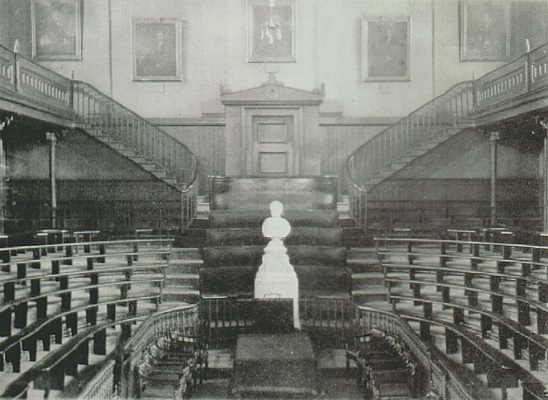
The Royal High School of Edinburgh is one of the oldest and most renowned schools in Scotland, with a rich history and a strong academic reputation. The Royal High School was founded in 1128, making it one of the oldest schools in Scotland. Originally situated on the grounds of Holyrood Abbey, the school later moved to its current location on Regent Road in 1829. The building itself is an impressive neoclassical structure designed by architect Thomas Hamilton, resembling the architecture of the Parthenon in Athens.
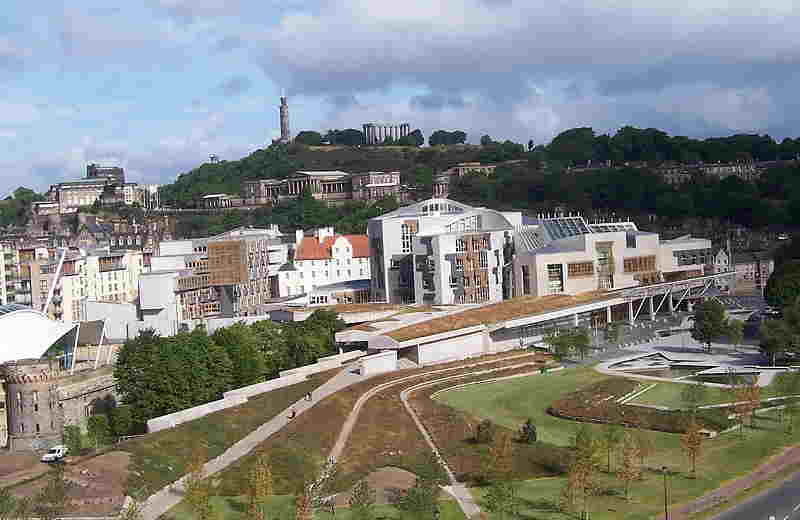
The Scottish Parliament Building is the home of the devolved Scottish Parliament, located in the Holyrood area of Edinburgh. The building was designed by Spanish architect Enric Miralles and opened in 2004. The building was designed to be a modern interpretation of Scottish vernacular architecture, with a contemporary twist. The structure is made up of two parts: the Debating Chamber and the Garden Lobby. The Debating Chamber is the main legislative chamber and is located on the top floor of the building, with a curved roof and timber panelled walls. The Garden Lobby is a large, glass-fronted atrium at the base of the building, connecting the building to the surrounding gardens. The building is clad in a variety of materials, including stone, metal and wood. The exterior is made up of a series of interlocking shapes, with curved walls and zig-zag roofs. The stone walls are finished with a variety of textures, and the metal elements are coloured in shades of grey and green, reflecting the colours of the surrounding landscape. The building also features a variety of sculptural elements, created by Enric Miralles. These include the 'Moat', a series of water features which surround the building, and the 'Thistles', a series of metal thistles which line the roof of the building. The Scottish Parliament Building is a modern interpretation of Scottish vernacular architecture, and a unique addition to the Edinburgh skyline.
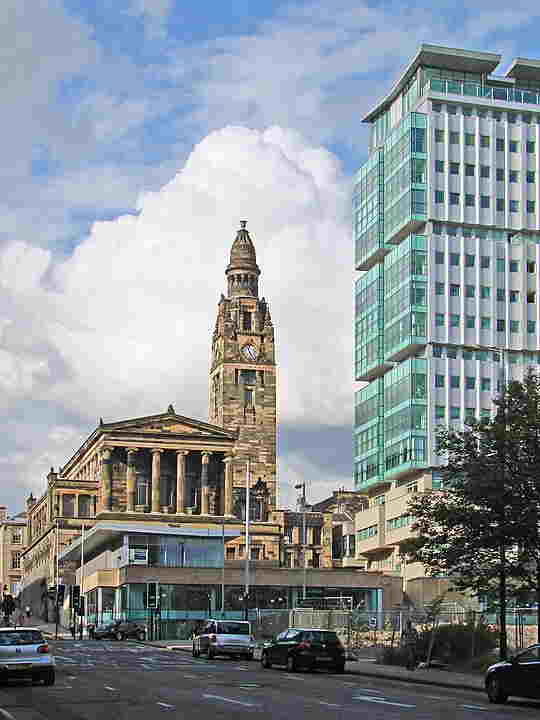
St Vincent Street Church is a Grade A-listed building located in the heart of Glasgow, Scotland, on the corner of St Vincent Street and West Regent Street. Constructed between 1859 and 1861, the church was designed by George Bell and is a striking example of the Gothic Revival style of architecture. The building is constructed from red and grey sandstone, with a tall spire and distinctive buttresses. Inside, the church has a stunning interior, with a large central nave and two side aisles, leading to a sanctuary. The ceiling is decorated with ornate stained glass windows and carved wood, and the walls are adorned with several beautiful murals. The church was built as part of a larger urban renewal project which saw a number of new churches being constructed in the city. It has served as a church for the local community, as well as a venue for concerts, lectures and other events.

The Glasgow School of Art (GSA) is an independent art school located in the city of Glasgow, Scotland. Founded in 1845 by the then Lord Provost of Glasgow, the school is considered to be one of the most prestigious art schools in the UK and has a long-standing reputation for excellence in teaching and research. The school is is located in the heart of Glasgow, in a beautiful Victorian building that was designed by Mackintosh and is now listed as a UNESCO World Heritage Site. The building itself is a work of art, from its grand staircase and hand-painted wallpapers to its beautiful stained glass windows.
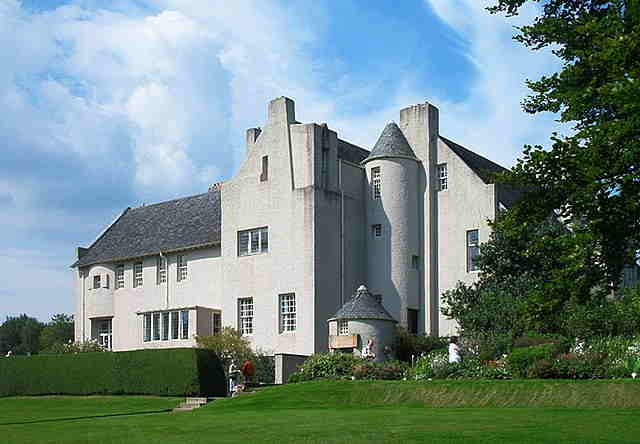
Hill House is a four storey Edwardian villa located in the town of Helensburgh, Scotland. It was designed by renowned Scottish architect Charles Rennie Mackintosh. The house was built in 1904 and is one of the finest examples of Mackintosh’s work. The house is situated on a steep hill and overlooks the River Clyde. The exterior of the house has a distinctive red sandstone facade which is typical of the Scottish Baronial style of architecture. The house is made up of a main block, with two extensions on either side. The main block has a grand, three-storey entrance hall, flanked by two wings and a large gabled roof. The interior of the house has been kept faithful to Mackintosh’s original design and features a mixture of traditional and modern elements. The interior is light and airy and full of character. The house includes seven bedrooms, five bathrooms, a living room, a dining room and a kitchen. The walls of the house are decorated with Mackintosh’s signature motifs, including stylised roses and thistles.
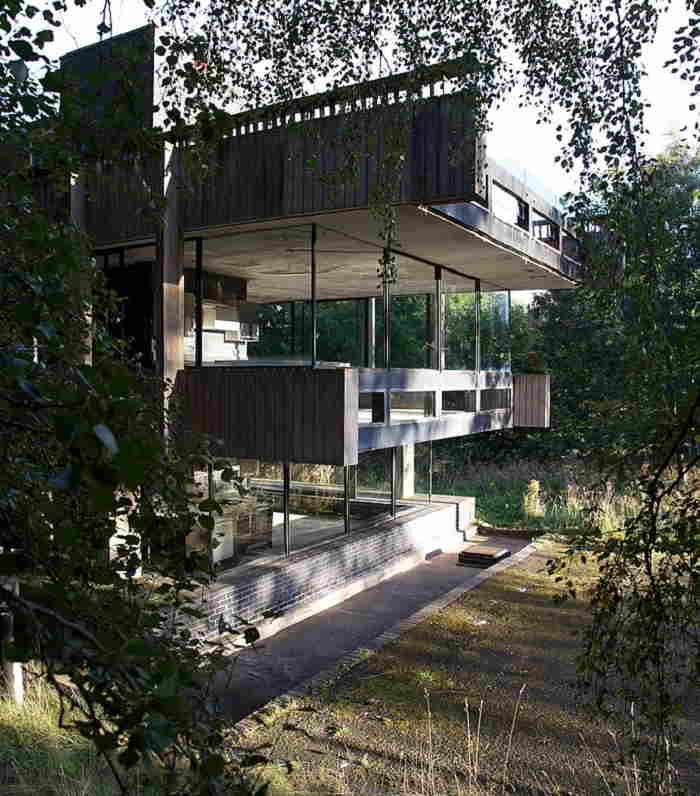
Bernat Klein Design Studio is located in the Scottish Borders town of Selkirk, nestled within the beautiful countryside. The design studio itself was housed in a unique building that reflected Klein's artistic sensibilities. The structure was designed by architect Peter Womersley, who was known for his modernist architectural style. Completed in 1957, the studio building became an iconic example of post-war modernist architecture in Scotland. The exterior of the studio featured clean lines, geometric shapes, and a minimalist aesthetic. It was constructed primarily with exposed concrete, glass, and natural stone, which blended harmoniously with the surrounding landscape. The building's design aimed to integrate with its environment and provide a serene and inspiring atmosphere for the creative work taking place inside. Inside the studio, large windows allowed ample natural light to fill the space, creating a bright and inviting environment. The interior design followed a similar modernist approach, with an emphasis on simplicity, functionality, and clean lines.
An Turas is a notable architectural project located on the Isle of Tiree in Scotland. The name "An Turas" translates to "The Journey" in Gaelic. It is a collaborative project between the artists and architects of the design firm Sutherland Hussey Harris and artist Alec Finlay. An Turas is a sculptural installation and shelter designed to provide a resting place and a sense of orientation for visitors exploring the coastal landscape of Tiree. It was completed in 2003 and has since become an important landmark on the island. The structure is made up of a series of interconnected, sculptural forms that incorporate a range of materials, including concrete, steel, and glass. It features elements such as seating areas, wind shelters, and information panels that provide insight into the local environment and culture. The design takes into consideration the harsh weather conditions of the island, providing refuge from the wind and rain while allowing visitors to engage with the surrounding landscape. An Turas stands as an example of how architecture and art can come together to enhance the experience of a place and create a meaningful connection between people, art, and the environment.
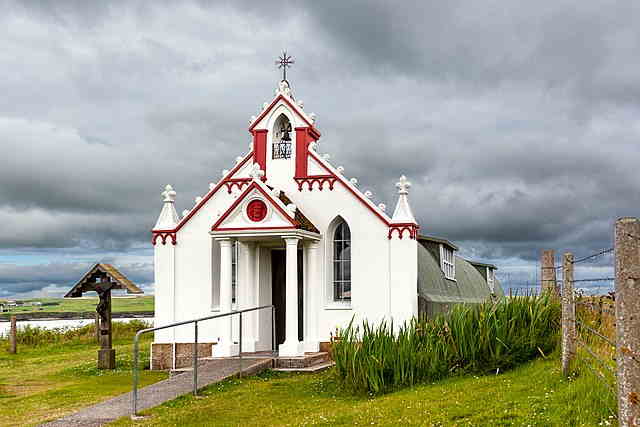
The Italian Chapel is a small, but beautiful chapel situated on Lamb Holm, one of the islands in the Orkney archipelago, off the north coast of Scotland. It was constructed during the Second World War by Italian prisoners of war, using two Nissen huts and salvaged materials. The chapel is now a nationally recognised monument and one of the most visited sites in Orkney. The camp was part of Operation Barlsey, a plan to construct a defensive causeway from the Orkney mainland to the island of Lamb Holm. The prisoners were put to work on the project and were given permission to build the chapel in their spare time. The chapel is made up of two Nissen huts which were joined together and decorated with a mixture of salvaged material and items brought in from Italy. The huts were transformed with the addition of a bell tower, an altar, several religious statues, and painted murals. The interior of the chapel is dominated by a large fresco depicting the Madonna and Child. The artist who painted the fresco was Domenico Chiocchetti, an Italian prisoner of war who was billeted at the camp. The chapel is still in use today and is maintained by a trust formed by the people of Orkney and the Italian Community.
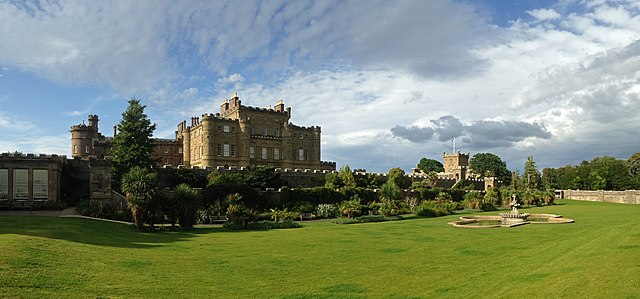
Culzean Castle is an impressive and imposing 18th century castle situated on the Ayrshire coast in Scotland. The castle is set in the midst of an estate of over 500 acres and is owned and maintained by the National Trust for Scotland. The castle is one of the finest examples of Scots baronial architecture in the country. It was designed by the great Scottish architect Robert Adam and was completed in 1792, with construction starting in 1777. The architecture is a blend of Palladian and Gothic styles, with a central grand hall, two towers and other grandiose features. The castle is surrounded by beautifully landscaped grounds including formal gardens, woodlands, ponds, and a deer park. Inside the castle there is a grand marble staircase and a number of stately rooms, including the Drawing Room, which has a beautiful ceiling painted by the French artist François Boucher, as well as a library and a number of other rooms. The castle also has a number of notable features, including a secret underground passage, a clock tower, and a series of tunnels and caves that were used to store and transport goods to the castle. The tunnels were built by the Earl of Cassillis in the late 18th century, and are still in use today.
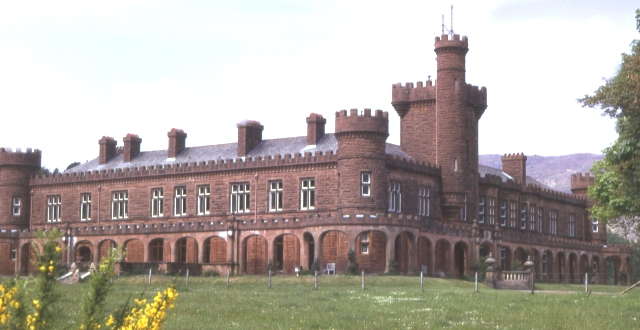
Kinloch Castle is a grand and stately castle situated on the Isle of Rum in Scotland. It was built in the late 19th century by the wealthy industrialist, Sir George Bullough. The castle is a sprawling and impressive structure, with its main tower reaching a height of over 50 feet. The castle itself is a mixture of Scottish Baronial and Arts and Crafts style, with external elements including turrets and battlements, and internal features such as intricate wooden panelling. The entrance is framed by two towers and leads into an impressive entrance hall, where visitors can admire the intricate wooden carvings and stained glass windows. From the entrance hall, a grand staircase leads up to the first floor, which contains a number of bedrooms, a library, and a drawing room. On the second floor, one can find the billiard room and the dining room, which has a large fireplace and a beautiful chandelier. The third floor is home to a ballroom, while the fourth floor is occupied by the servants’ quarters. The castle is surrounded by parkland and gardens, which were designed by the renowned landscape architect Thomas Mawson. Kinloch Castle is a great example of the grandeur and opulence of the late 19th century, and a reminder of the wealth and power of the Bullough family. Today, the castle is maintained by the Scottish Historic Environment Service, and is open to the public for tours and special events.